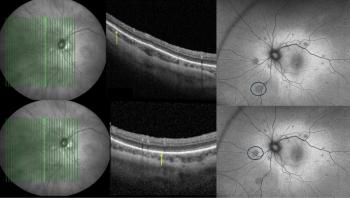
HELIOS trial 1-year results assess implant for treatment of non-proliferative diabetic retinopathy
Diana V. Do, MD, spoke on behalf of the HELIOS investigators at the Hawaiian Eye and Retina 2025 Meeting, in Kauai, HI
Investigators shared 1-year results from the HELIOS Trial, which evaluated the investigational intravitreal AXPAXLI implant (OTX-TKI, Ocular Therapeutix) for the treatment of non-proliferative diabetic retinopathy (NPDR). According to investigators, the treatment showed stability or improvement in the Diabetic Retinopathy Severity Scale (DRSS) and generally the drug was well tolerated.
Diana V. Do, MD, Professor of Ophthalmology and Vice Chair for Clinical Affairs at the Byers Eye Institute, Stanford University, Los Altos, CA, and Clinic Chief of Ophthalmology at Stanford Health Care, Stanford, CA, spoke on behalf of the HELIOS investigators at the Hawaiian Eye and Retina 2025 Meeting, in Kauai, HI.
OTX-TKI is a sustained-release drug in hydrogel that was evaluated in a multicentre, double-masked, randomised parallel-group study of patients with moderately severe to severe NPDR without center-involved diabetic macular oedema (CI-DMO). One intravitreal bioresorbable hydrogel injection allows sustained release of the drug for 6 to 12 months.
She enumerated the key takeaways from the phase 1 trial:
- OTX-TKI showed DRSS stability or improvement with durability through 48 weeks; 23.1% of patients in the OTX-TKI arm had a 2-step or greater DRSS improvement, and 46.2% of patients had a 1- or 2-step or greater DRSS improvement at 48 weeks. The DRSS did not worsen at 48 weeks in any patients in the OTX-TKI arm.
- No patients in the OTX-TKI arm developed PDR or CI-DME through week 48; in contrast, in the sham control arm, 37.5% developed PDR or CI-DMO through week 48.
- A single OTX-TKI injection showed durable fluid suppression and more stable fluid control through week 48.
- OTX-TKI was generally well tolerated with no incidence of treatment or injection procedure-related intraocular inflammation, iritis, vitritis or vasculitis.
Study importance
DR is a chronic, progressive and burdensome disease for which earlier treatment is needed to prevent progression, Do pointed out. While the efficacy of anti-vascular endothelial growth factor (VEGF) therapy and need for proactive treatment of NPDR has been established in the PANORAMA and Protocol W studies,1,2 less than 1% of patients with NPDR received anti-VEGF therapy and most retina specialists (62.7%) do not recommend treating patients with NPDR if they do not have DMO.3-5
This has resulted in what Do described as an unsustainable treatment burden of frequent injections and worse outcomes in eyes that had interrupted or reduced treatment compared to those never treated at all.6
“There is an unmet need for early intervention with a longer-lasting treatment option,” she emphasised.
AXPAXLI’s efficacy and safety profiles have not been established, and it has not been approved by the FDA or any other health agency.
References
Maturi RK, Glassman AR, Josic K, et al. Four-year visual outcomes in the protocol w randomized trial of intravitreous aflibercept for prevention of vision-threatening complications of diabetic retinopathy. JAMA. 2023;329:376-385.
Brown DM, Wykoff CC, Boyer D, et al. Evaluation of intravitreal aflibercept for the treatment of severe nonproliferative diabetic retinopathyresults from the PANORAMA randomized clinical trial. JAMA Ophthalmol. 2021;139:946-955.
Market Scope. 2022 Retinal Pharmaceuticals Market Report: Global analysis for 2021 to 2027. Published August 2022.
Market Scope. US Retina Quarterly Update: O2 2022 analysis of historical trends and latest developments. Published August 2022
Hahn P, Garg SJ, eds. 2023 Global trends in retina survey. Chicago, IL. American Society of Retina Specialists; 2023.
Goldberg RA, Hill L, Davis T, Stoilov I. Effect of less aggressive treatment on diabetic retinopathy severity scale scores: analyses of the RIDE and RISE open-label extension. BMJ Open Ophthalmol. 2022;7:e001007.
Newsletter
Get the essential updates shaping the future of pharma manufacturing and compliance—subscribe today to Pharmaceutical Technology and never miss a breakthrough.













































